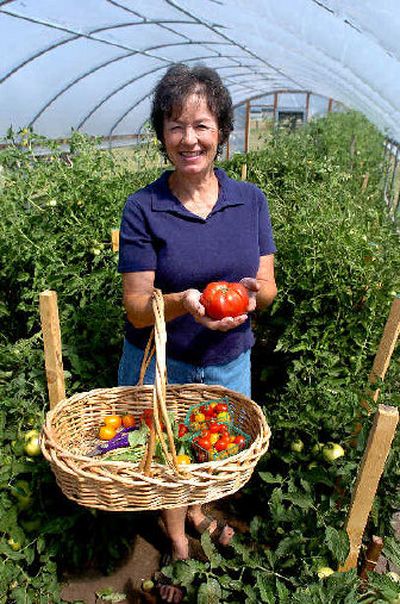The Tomato Lady

Her tomatoes are green, but there is little chance that Susi Faville, “The Tomato Lady,” will go hungry. Strawberry plants won’t quit bearing fruit and softball-sized peppers are begging to be picked on her Mountain View Farm in Hayden.
Faville is a regular at the Kootenai County Farmers’ Market along with her business and social partner, Brian Howard. They’ve held down the southwest corner booth on Saturday mornings for 12 years. Faville turned a two-acre plot on Ramsey Road into a cornucopia of produce, but it’s the tomatoes that became her trademark.
Several years ago, while attending a play in Coeur d’Alene, someone recognized Faville from the farmers’ market. “Oh, you’re the tomato lady,” he said, as Faville recalled.
She decided to brand herself with the name. Faville takes pride in selling high-quality, hearty tomato plants that suit Idaho’s climate. She believes that the trouble with buying starter plants from “big box” stores is that the plants are trained to have a chemical dependency. Her magic method includes sunshine, natural fertilizers and no pesticides.
“I don’t baby them,” she said. “My plants are tough.”
She encourages her customers to expand their tastes beyond Early Girl, a popular standby for Idaho residents.
“Others taste really good and grow just as easily,” she said.
Cherokee Purple and Ida Gold are two of the 26 varieties Faville grew this summer. Bloody Butcher, Green Zebra and 4th of July round out the mix. Sun Sugar miniatures are most popular with the clientele. She encourages buyers to give petite tomatoes a chance and insists that they are often more flavorful than the huge, beefy ones.
Idaho’s growing season may seem short, but it is anything but brief for Faville. Her work begins in December when she spends several days selecting and ordering seeds. A small respite is granted in January and then Faville is starting plants from hundreds of seeds in her kitchen and setting them up with a basement light. Nearing March, they grow large enough to separate into pots and make their way into her spacious greenhouse. It takes about six weeks from seed to sale. She staggers planting so she is ready with her offerings throughout the early spring selling season.
By August, a tangled web of tomato vines threatens to take over the south side of her greenhouse. Faville considers this the “dormant season” for the Tomato Lady. She sold oodles of plants already and waits for salable fruit. Entwined vines hide green tomatoes that range from the size of a grape to a pint-sized grapefruit.
At the farmers’ market, Faville dispenses advice along with her produce. She distributes a flyer filled with tips on how to make tomatoes thrive. Water them infrequently, but deeply, to encourage a large, deep root mass, she advises. Add a bit of calcium to prevent blossom end rot.
“We give a ton of advice,” Faville said. “That’s part of the deal with the farmers’ market. I really love the role of being an educator. They want to know how to grow things on their own and without chemicals.”
Sharing secrets hasn’t affected the return of customers each season. Faville estimates that she sold nearly 4,000 tomato plants this spring. Besides tomatoes, she sells perennials, herbs, hanging baskets, annuals and other vegetable starts. Last season she was picking 200 pounds of tomatoes per week in the height of the season, which runs from the end of August through early September. She sold every last one. She guards just a few secrets from the public, such as the ingredients in her strawberry/jalapeño jam.
At times, the number of plants seems overwhelming to Faville. A typical day starts at 7 a.m. and runs until close to sunset.
“If it’s 8 p.m. and I’m still working, I stop,” she said.
Faville has 100 varieties of iris she is currently digging up for customers who have visited her farm. There are chicks to feed, two dogs to love and regular visits from aphids and earwigs. Faville’s remedies for pests are soap, a stomp of the foot or crushing them between her fingers. A cat slinks through the shadows beneath a row of her “volunteer” sunflowers. They have sprouted from a prior year’s seeds or a donation from visiting birds.
“I don’t even know who some of these are,” she said of the flowers.
The golden flowers will sell, along with dried decorative wreaths, garlic braids and lavender sachets. The goods may be stockpiled along with wild grasses and tansy that Faville gathers to use in winter craft fairs as her season winds down.
“Some of our best days are in the fall,” she said.
Winter squash, pumpkins and Indian corn find a spot in the garden. After the frost, there is the yard cleanup, which lasts through early winter. Faville started her career as a maintenance gardener, tending gardens that belonged to other people in California. She moved to North Idaho in 1992, retired and started gardening “like crazy” as a hobby. She met Howard at the farmers’ market and they began growing plants together. Their crops are complementary, not competing. He takes care of the garlic, squash and zucchini and his potatoes are the best, Faville said.
The tomatoes are her domain and she considers them the easiest part of the business.
“It seems to be an affinity for me,” she said. “If I did nothing else, I’d probably grow tomatoes.”